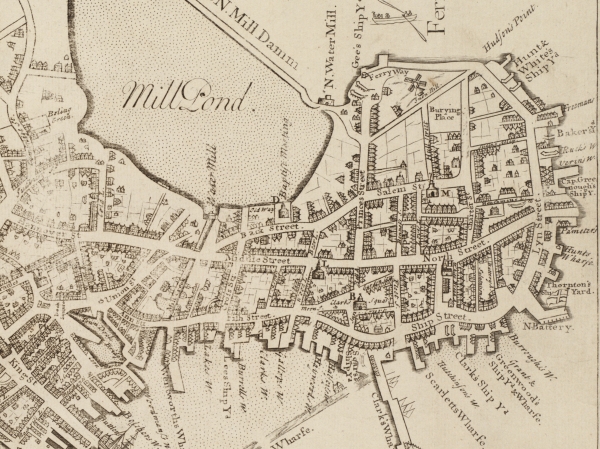· 1 ·
Boston and Its Furnituremakers, 1650–1860
J. RITCHIE GARRISON
One of the challenges for scholars studying American furniture is to understand why Boston became a center for production and how conditions of design and fabrication changed. To understand the city’s craft community and its evolution, we must focus on three major themes. Boston’s furniture production was part of a regional and Atlantic World economy. Inequalities—too much skilled labor and production for a local market, too few resources to exist in isolation, and too much competition to remain conservative for long—drove artisans’ decisions. And over time, the city’s furnituremakers adapted to high land costs, capricious markets, over-production, greater profits in other economic sectors, and increased capital requirements. Although the broad contours of these changes are understood, many of the implications are not. Boston’s best furnituremakers made beautiful objects, but many of them struggled to make a living.1
As a maritime outlier in a mostly agrarian world, Boston was a focal point of administration, trade, and shipping for the patchy accretion of first-generation settlements linked to the Hub by roads, rivers, and estuaries. Concentrated on a two-by-one mile isthmus (fig. 1), the town grew rapidly in the dozen years between its founding in 1630 and 1642. The outbreak of the English Civil War (1642–51) dramatically slowed immigration to New England and effectively halted the flow of money the newcomers brought with them—the metropolitan credits and hard currencythat Boston’s earliest merchants had used to settle international accounts with English suppliers. Other than fish, Englishmen did not need much of what early New Englanders produced, especially with trans-Atlantic freight charges added to goods that were already available in sections of northern and central Europe. The resulting credit crunch set off a search for alternative sources of credit that would pay for many basic goods that were then imported because the demand for textiles, shoes, leather, metals, paper, salt, books, and tools far outstripped local production even if they were available. To pay their bills, New Englanders had to find something to exchange in markets that needed or would pay for what they had.2
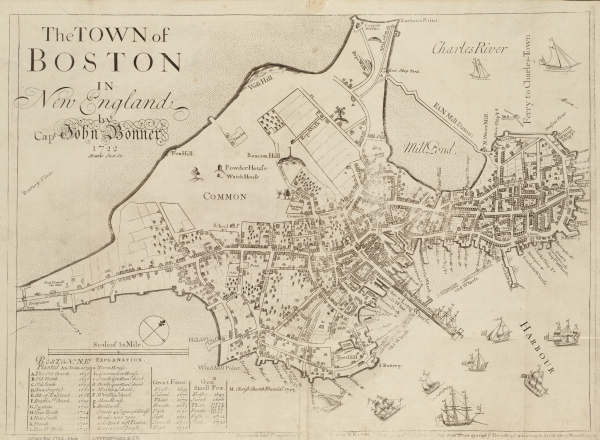
FIG. 1. The Town of Boston in New England by Capt John Bonner 1722, drawn by John Bonner (1643–1726), engraved and printed by Francis Dewing (active ca. 1716–22), Boston, 1722. Engraving on laid paper; h 16⅞, w 23⅜. The Norman B. Leventhal Map Center at the Boston Public Library.
TABLE 1.
| 1650 | 1680 | 1710 | 1742 | 1780 | 1800 | 1830 | 1860 |
|---|---|---|---|---|---|---|---|
|
2,000 |
4,500 |
9,000 |
16,382 |
16,000 |
24,937 |
61,392 |
177,840 |
Source: Lawrence W. Kennedy, Planning the City upon the Hill: Boston since 1630 (Amherst: University of Massachusetts Press, 1992).
Residents had few alternatives. A considerable portion of the peninsula was taken up by three steep hills and a large tidal mill pond ill suited to farming or easy communication between one side of town and the other. To the west and south were tidal marshes that hindered maritime access. Local resources were becoming scarce. The increase in construction and clearing quickly reduced the supply of timber, causing even the earliest residents to depend on others outside the town for food, fuel, and building materials. Puritans may have sought a spiritual commonwealth, but they had to trade or else they were bound to freeze and starve.3
For decades, Boston was the largest town in British North America, enjoying many of the amenities that dense concentrations of people can sustain. It doubled in size until the 1740s, after which its population stagnated. Growth resumed in the early nineteenth century and proceeded unevenly during the next several decades (see table 1). Meanwhile, areas outside Boston expanded rapidly, helping to maintain demand for its products even as the city’s population stalled and declined. Still, Boston’s landscape changed slowly between 1722, when John Bonner published the first detailed map of the town (see fig. 1), and 1800. Thereafter, residents filled shallow waters and subdivided city lots, increasing population density.4
Given the city’s trade connections, local merchants and residents were well aware of what was happening elsewhere, whether in Kingston, Bristol, or London. The number of turners, joiners, housewrights, carvers, upholsterers, painter-stainers, japanners, caners, lumber dealers, booksellers, and others able to earn a living reminds us that Boston’s economy was interconnected, outwardly focused, and highly competitive. Workers could shift energies as opportunities emerged, but only to a point. They clustered close to the docks, benefitted from kinship ties, and were creative, not merely emulative. Boston’s blockfront furniture and high chests, to cite just two examples, were not reproductions of London’s published fashion plates, and such forms should not be interpreted as provincial naiveté (fig. 2).5
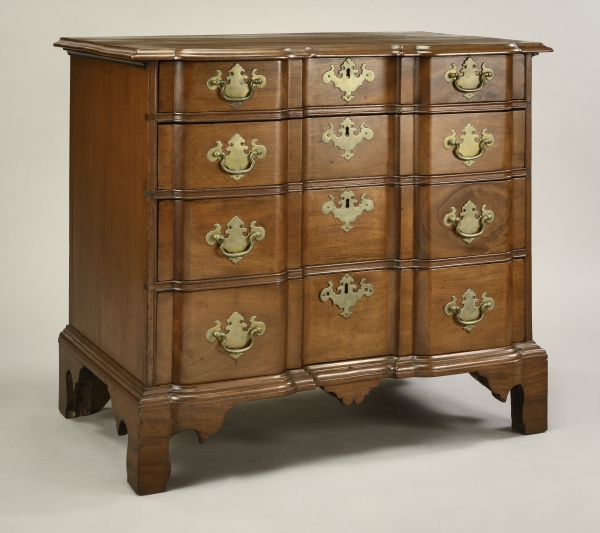
FIG. 2. Chest of drawers, Boston, 1750–80. Mahogany, white pine; h 31, w 35⅝, d 21¼. Winterthur Museum; Gift of Mrs. Duncan I. Selfridge (1957.0032.001).
The driving forces behind Boston’s craft community were markets attuned to the “middling sort,” rather than abstract notions of stylistic competition with London elites. Connoisseurs may rightly wonder why the city failed to embrace more quickly the implications of the rococo in the eighteenth century. They point to the tightly knit kinship networks, the city’s poor record of support for immigrants, and wartime hardships to explain furnituremakers’ inability or unwillingness to keep up with published fashions. Implied in this interpretation is the teleological argument that Bostonians should have followed the dictates of fashion plates or the standards of London. The simpler explanation is that profits trumped design. For a long time, Boston’s ships and chairs were highly competitive products that encouraged specialization, diversification, and a coordinated approach to the division of labor.6
We can see some of the patterns behind this specialization in early maps. For most of the seventeenth and eighteenth centuries, Boston residents were concentrated adjacent to the cove near the middle of the town, on land that straddled Mill Creek and led to the Town Dock from Mill Pond (fig. 3). They also settled in the North End, whose northern portions offered good slopes for several shipyards and deeper water close to shore that was suitable for wharves, lumberyards, warehouses, and the landing of bulk items such as cordwood. Linking the North End with Boston’s center was Dock Square, the core of the town’s produce market. Running south from Dock Square was the axial route down the peninsula to Roxbury and the South Shore, then known by its segments: Cornhill, Marlborough Street, Newbury Street, and Orange Street (fig. 4). Commercial areas were located in the South Cove, but prior to the 1720s, Boston’s residents tended to live in areas farther north of Milk Street or along Newbury and Orange Streets. On the city fringes were the ropewalks, industrially scaled businesses of quarter-mile-long sheds filled with flammable materials such as tow, pitch, and tar. If one end of a building caught fire, chances were good the flames would spread to the other end. Not many people wanted to live near the ropewalks, restraining nearby real estate prices.7
FIG. 3. The North End at the right and Dock Square and the Town Dock at the left, as seen in the Bonner map in fig. 1.
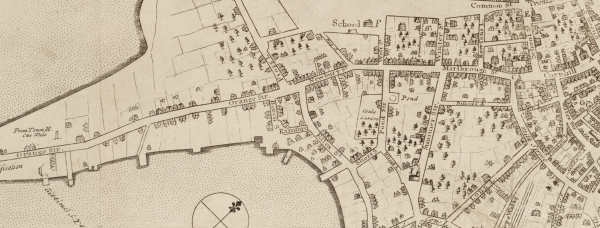
FIG. 4. The South End and the “Neck” that linked Boston to Roxbury at the left, as seen in the Bonner map in fig. 1.
Most turners, joiners, and cabinetmakers did not work in shipyards, but they were not far from them either. In 1687, 76 percent of vessels sailing from Boston were registered there, and by 1702 only London and Bristol were more important in terms of registered shipping tonnage (although that rank would change as the British economy grew). This figure is astonishing for a community of about eight thousand and barely seventy years old. To understand the connections between this maritime world and the products of local furnituremakers, we need to think about the problem of scale and the networks of exchange. By the 1660s, Boston and coastal New England had become a center for shipbuilding and lumber trading, but the signs of this status appeared much earlier. When the first New England sawmills went into production in the 1630s, labor-short Massachusetts was using technology that sawyers in England resisted because it threatened to put many of them out of work. In some aspects of the woodworking trades, including sawmilling and shipbuilding, Boston operated on the cutting edge. It benefitted from being new, from not having to address the politics of established work relationships.8
It is easy to overstate Boston’s place in the world during the early decades of its growth. The numbers appear large because every other colonial city was so much smaller. Much of Boston’s freight went out via vessels of 20 to 40 tons, the sloops and ketches that crews of three to five people (four are visible in the Burgis print) could manage on voyages up and down the coast or to the Caribbean (fig. 5). Small enough to navigate creeks and ports that three-masted merchantmen were too large to enter or profitably engage, these craft could tramp for months taking in and selling whatever they wished, including the products of Boston’s furnituremakers.9
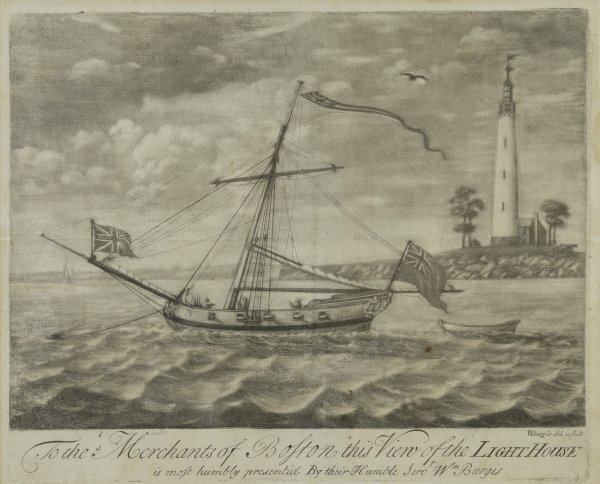
FIG. 5. To the Merchants of Boston this View of the Light House is most humbly presented By their Humble Servt Wm Burgis, drawn and engraved by William Burgis (active ca. 1717–ca. 1731), Boston, 1729. Mezzotint on laid paper; h 813/16, w 12⅛ (image). Winterthur Museum; Museum purchase with funds provided by the Special Fund for Collection Objects (1990.0074 a).
Compared to a ship or a house, furniture seems simple. Ships—even the small ones typically produced by New Englanders—require a complex array of subassemblies made up of different materials fabricated by people with varied skills, from shipwrights, caulkers, and riggers to turners, mastmakers, and sailmakers. Vessels tied up significant amounts of capital and were a constant maintenance headache; they made money only when they were moving. Speed was important: the faster you built a ship and put it into service, the quicker you recouped your investment, even when it was spread among multiple partners. If pirates, storms, spooked fish, wars, and bad economic timing didn’t sink you, rot or shipworms would. Boston’s early woodworkers understood the advantages of economies of scale, division of labor, and diversification. The first two factors tended to increase productivity. The last allowed specialists to hedge their bets by making something that would sell in small markets. Workers might operate in family-run shops, but they were part of a bigger whole.10
Among Boston’s seventeenth- and early eighteenth-century furnituremakers, these conditions were most visible in the production of chairs, a product consumers tended to buy in sets and that were therefore supposed to look more or less alike (fig. 6). Thanks to many American scholars and their British colleagues, we know quite a bit about Boston’s early chairmakers, even if we know less than we would like about their production volume and trading relationships. The Boston appraisers who inventoried the estate of Nathaniel Adams Sr., a turner, on November 1, 1675, recorded an array of goods and stock—some of which Adams probably imported—that indicate he earned his living entirely as a craftsman. He also seems to have made ship’s blocks. With a population then estimated at less than five thousand, including the elderly and children, this level of production and inventory far exceeded local needs. Adams had diversified his product lines, but the range of wares reminds us that furniture was often only one part of a craftsman’s output. Less than fifty years after the founding of the Massachusetts Bay Colony, Boston woodworkers were exploiting a high-volume, low unit-cost export market in finished goods.11
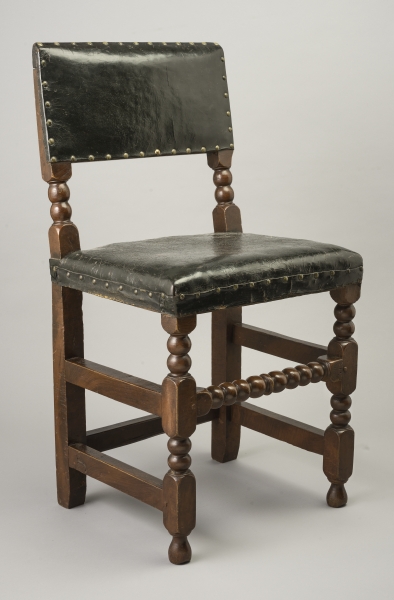
FIG. 6. Side chair, Boston, 1665–95. Red maple, red oak; h 36, w 18½, Seat d 15¼. Winterthur Museum; Gift of Henry Francis du Pont (1958.0694).
No chair form was more important than the cane chair, which became relatively common by the late 1680s and evolved over the next half century (fig. 7). Imported London chairs flooded the colonies and Philadelphia chairmakers produced some examples, but Boston craftsmen dominated the market in terms of American-made cane chairs. The form had turned rear stiles (some of which were made using multiaxis lathes), turned and sometimes carved front stiles, stretchers, carved crest rails, and joined seat and back frames that could support cane, splint, rush, or leather upholstery. The cheaper versions were usually made of maple and painted black or stained reddish brown to simulate walnut; costlier and more refined versions might be made of imported walnut, a far more expensive wood. The chairs were the products of subcontracted specialist turners, carvers, joiners, caners, upholsterers, and painter-stainers who combined efforts to make these wares efficiently and cheaply.12
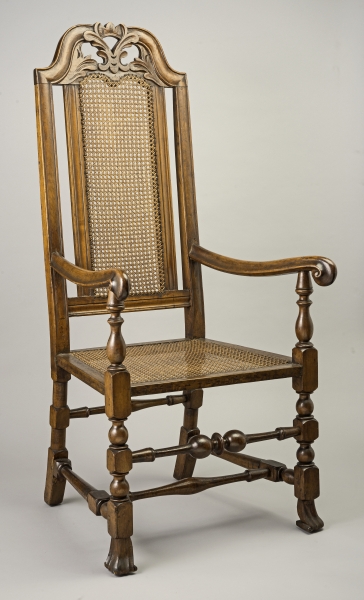
FIG. 7. Armchair, Boston, 1720–30. Maple; h 49⅞, w 24, Seat d 21. Winterthur Museum; Bequest of Henry Francis du Pont (1954.0528).
Adams’s inventory lists “timber at the wharf,” implicating the degree to which artisans in Boston depended on trade. Early residents built wharves in strategic locations to shelter coastal vessels from storms and to aid loading and unloading, but deeper-draft vessels typically had to lighter freight to shore via small boats. As registered tonnage increased, the town eased congestion with a bold economic gamble. In 1711, city authorities authorized proprietors to begin construction of Long Wharf, a huge docking facility that stretched a third of a mile into the harbor. Completed by 1715, Long Wharf was able to service the deepest-draft ships, allowing several large vessels at once to tie up, load, and unload. Its success prompted government officials in other colonies to charge that New Englanders were in violation of the Navigation Acts. Lieutenant Governor William Gooch of Virginia complained to the Board of Trade in 1733 that “scrutoires, chairs and other wooden manufactures . . . are now being exported from thence to the other plantations, which, if not prevented, may be of ill-consequence to the trade and manufactures of this kingdom.”13
Gooch’s grumbling echoed what inventories from the Upper South and Middle Atlantic already showed: many common leather chairs, whether of the low-back stool variety (see fig. 6) or the high-back early baroque forms (fig. 8), were listed as made in either Boston or New England. These chairs had become commodities by the 1660s and were still selling well in 1706 when Thomas Fitch, a Boston upholsterer and merchant, wrote to his New York agent Benjamin Faneuil (father of Peter Faneuil) that he was unable to keep up with the volume of business in New York. By 1709, however, his carved consignments were doing poorly, and he complained to Faneuil that “tho some are carved yet I make six plain to one carved; and can’t make the plain so fast as they are bespoke.” He added that these chairs were still in fashion in Boston and urged Faneuil to try to force a sale, even if he had to accept a lower price. The exchange reflected a new reality in colonial political economies: in 1660, New England’s population was more than five times larger than that of the middle colonies; by 1710 the ratio had slipped to less than 2 to 1. The export of New England furniture and other commodities was increasingly subject to competition as the market continued to segment. Fitch could accurately claim that his carved chairs were as fashionable as those from London, but New Yorkers preferred and bought plainer versions at lower price points.14
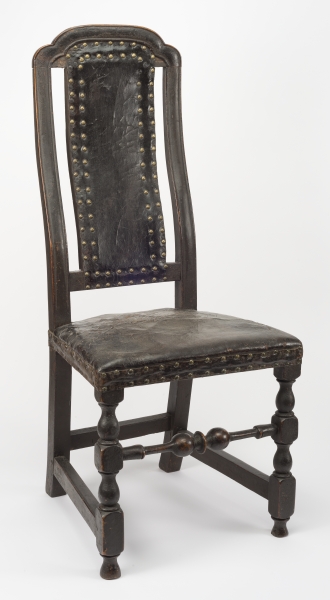
FIG. 8. Side chair, Boston, 1730–40. Maple; h 43¼, w 18¾, d 18½. Winterthur Museum; Acquired in exchange with the William Penn Memorial Museum (1981.0046).
Even in the early eighteenth century, a few key skilled workers—carvers, japanners, caners—immigrant or native born, could transform the production of a town. Though dispersed throughout Boston, furniture trades were concentrated in particular areas. Several turners and chairmakers were located south of King Street near Fort Hill. An early grouping settled around the Town Dock, in nearby Union Street, and on Ann and Fish Streets, roads that followed the contour of the seaside wharves and connected commerce from north and south of town. The docks were also the entry point of immigrants, including some artisans. John Lane, from London, advertised in the Boston Gazette in 1730 that he “Canes and Bottoms both New and Old Chairs, after the best manner, over against Dr. Cooke’s in School Street.” Lane may have trained his wife, Sarah, who carried on the business after his death in 1737, a fact she advertised after her marriage to John Goodwin a year later. Of course, it is possible that it was Sarah who trained Lane. Men were not the only agents of change in the furniture trades; it is just harder to find women in the documentary record.15
We must be cautious about assuming that the political and economic problems confronted by Massachusetts residents and governments in the eighteenth century caused a drastic declension in Boston’s furniture business. Artisans certainly faced many challenges. A series of imperial wars roiled the colony’s fortunes, affecting New Englanders more than residents of other colonies because of the proximity of New France. Boston both suffered and profited from these conflicts. Some merchant contractors grew wealthy from provisioning troops, but many of the town’s young men died from combat or disease. The worst period was 1745–46, when, according to one historian, an estimated 8 percent of men in Massachusetts died. Boston filled with widows and orphans and its population stagnated while New York and Philadelphia grew. The flood of European immigrants mostly bypassed New England in favor of the Middle Atlantic or Upper South, where economic prospects seemed brighter. The problem for historians is to reconcile the economic consequences of the wars, the continued output of Boston’s craftsmen, and the expansion of production in other New England towns, such as Salem and, most famously, Newport.16
Countering this demographic, political, and economic collapse was material progress, evident not only in Boston but in other parts of the region as well. If the city had a disproportionate number of widows and orphans to care for, it continued to be the home of people of means who patronized local craftsmen. It also remained a service center for both its own hinterlands and the Atlantic World, for few other places could readily sustain such a diversity of trades. Furnituremakers continued to make chairs, tables, and chests that sold well and profited from the same coordination of specialty contracting that had earlier energized architecture, chairmaking, and shipbuilding. What the scholarship on Boston furniture clearly reveals is a growing complexity of forms, styles, price points, and consumer choices as competition heated up within and outside New England amid changes in the cost and availability of materials such as textiles and wood (figs. 9, 10). Some furniture forms, including Boston chairs, would benefit from commodification, whereas others—high chests, bombé desks, clothespresses, or sofas—remained bespoke work for people of means.17
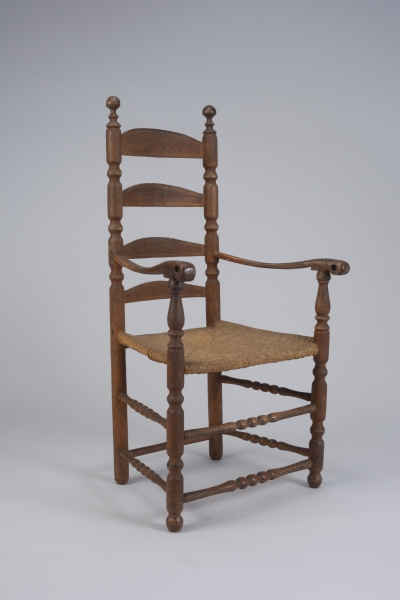
FIG. 9. Armchair, Boston, 1720–50. Poplar, ash, oak; h 43, w 24⅞, Seat d 15⅞. Historic New England; Gift of Margaret Carson Holt (1970.420).
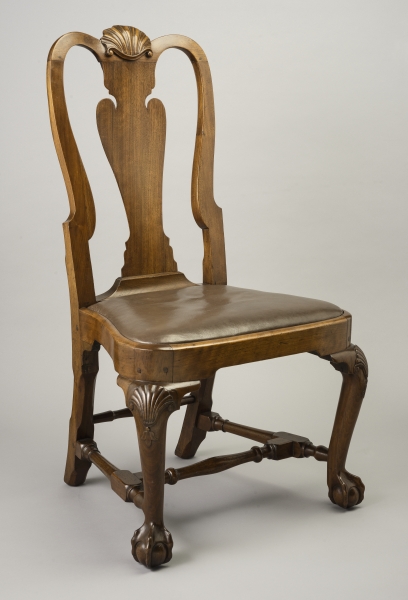
FIG. 10. Side chair, Boston, 1740–65. Black walnut, soft maple; h 39, w 21⅜, d 20. Winterthur Museum; Bequest of Henry Francis du Pont (1960.0719.001).
The fire of March 20, 1760, that destroyed much of the neighborhood around Batterymarch and Milk Streets generated some of the best documentary information about artisan tools and production of the era. Isaiah Audebert was thirty-six years old when the blaze consumed his house, shop, tools, lumber, sixty black-walnut feet, three Marlborough chairs, and seven mahogany chairs. When he died nine years later, Audebert had managed to recover, and his estate was probated at £407.8.5. Almost £14 (3 percent) was attributed to his tools and lumber, suggesting that the capital necessary for becoming a chairmaker was not high compared to other trades.18
By contrast, William Crockford specialized by turning stair and fence balusters (including twisted balusters), treen wares, ship’s fittings, and furniture parts such as tabletops, bedposts, and table pedestals (often referred to in the period as pillars). His inventory, taken in 1756, recorded a well-equipped shop that contained turning tools, rasps (one of the most underappreciated implements in eighteenth-century furniture shops), three lathes with specialized mandrels (probably for faceplate and offset turning), two benches, and expensive “engine tools” (possibly for turning twisted balusters and newel posts). Included in the inventory were hardware, handles for “hatters bows,” ivory, “teeth,” fire-screen poles, and stand and tea table tops. This versatile manufactory probably employed about three to six workers who could handle a variety of turning work subcontracted by some of Boston’s best cabinetmakers, shipwrights, housewrights, and tradespeople.19
Crockford was clearly a special case of an artisan who prospered because of his sobriety, diligence, and skill. Stephen and William Fullerton Jr., both chairmakers, managed to get into various legal scrapes for indebtedness or burglary and then suffered great losses from the 1760 fire. Reduced to ashes were thirty-three chairs, three roundabout chairs, a table chair, one thousand bundles of flag, and Stephen’s house and shop; William assigned a total of £120 for the destroyed materials, tools, and completed work. Neither ever fully recovered and thereafter scraped by.20
The comparison is instructive. Crockford created a highly specialized niche that not only addressed the needs and wants of the mercantile elite for decorative twist-turned staircases and fences but also provided countless opportunities for the kind of ordinary work everyone needed occasionally. He hedged against the competition by investing in specialized equipment with high capital costs (engine tools) to increase quality and productivity. The Fullertons were two of many chairmakers who competed for business with higher-volume, relatively low-cost wares, making chairs in batches with flag seats rather than worsted wool upholstery. All three examples—Audebert, Crockford, and the Fullertons—provoke questions about the ways and means of making and selling furniture in Boston.
By the mid-eighteenth century, and probably much earlier, the furniture business had clearly begun segmenting into forms that, in the nineteenth century, people would describe as manufacturing and retailing. Among furnituremakers, the export business in chairs led the way by turning objects into commodities detached from producers in much the same way that the export of European textiles had long shaped trade in the Atlantic World. Consumers could still go to their neighborhood joiner or cabinetmaker and buy something handmade from local materials at a variety of price points. But relentless competition, new tools, improved productivity, design variations, imported materials, and higher expectations for fit and finish fundamentally altered the trades. The person from whom you acquired a piece of furniture was probably part of a long commodity chain that operated largely out of sight.21
At the high end of the trade was bespoke work for polite society, including the masterpieces that now populate many museum collections. These were the objects that consumed resources: time, labor, subcontractor costs, and expensive materials, in addition to customs duties and freight and insurance charges if buyers had to ship them (fig. 11). They are, therefore, the pieces most likely to reflect local sourcing and consumption patterns because such orders often depended on face-to-face relationships between makers and buyers particular about their wants. The bottom of the market included items (slat-back chairs, for example) that cost more to ship than they were worth. The real money in exports was in the middling products made for local, regional, and colonial consumers. In many cases, these objects were simpler, more affordable, and less costly to ship than such forms as blockfront or bombé chests. It was at this price point that Boston furnituremakers felt the competition, for what was true for Boston applied elsewhere as well.22
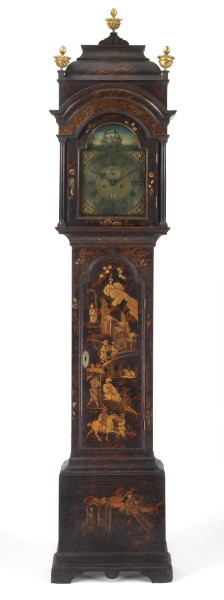
FIG. 11. Tall-case clock, works by Gawen Brown (1719–1801), Boston, 1745–55. White pine; h 94½, w 22⅛, d 10⅝. Winterthur Museum; Museum purchase (1955.0096.003).
As Benno M. Forman pointed out in the 1970s, the relentless logic of production choices in the seventeenth century had already segmented subcontracted labor into turners, joiners, carvers, cane workers, upholsterers, and finishers, depending on the chair design. It had also congregated the trade within the city. Few rural tradespeople had ready access to multiaxis jigs for lathes, carving tools, or supplies of cane and leather, nor did they have sufficient demand to justify tooling up, acquiring imported materials like cane, or learning esoteric skills. Yet, once workers subcontracted to increase productivity, they also limited their ability to alter an existing design—without implementing template innovations at several shops. It was easier to adjust minor features such as crest rails or splats than to develop an entirely new form that required prototyping and retooling. The challenge for woodworkers in Boston (and, for that matter, Newport) was not the rococo style as a fashion problem. It was the Windsor chair (fig. 12).23
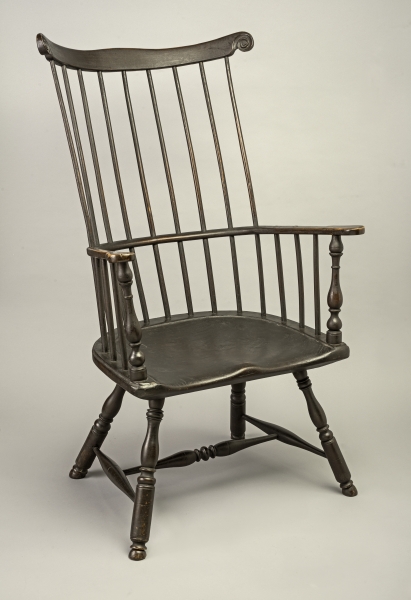
FIG. 12. Windsor armchair, attributed to Francis Trumble (ca. 1716–1798), Philadelphia, 1755–62. Yellow poplar, maple, hickory; h 44⅞, w 26⅞, d 26¾. Winterthur Museum; Museum purchase (1978.0106).
The Windsor chair is the most important furniture style ever produced in America. Introduced in Philadelphia from England in the late 1710s or early 1720s, it has never gone out of production. Although Windsor-chair makers in urban areas took advantage of subcontracting, the form could be fabricated in either the city or the country, in household shops or, later, in factories. Makers could use local woods, simple tools with low capital-cost barriers, and paint for finishes. The form hit a sweet spot between stylishness and price: the chairs were durable, comfortable, and relatively cheap to buy in sets. At the time of the Revolution, Windsor chairs were supporting the posteriors of the founding fathers in Independence Hall, and by 1800, a large percentage of American country farmhouses of the middling sort had sets of Windsor or painted fancy chairs.24
Boston chairmakers, as discussed in the essay by Nancy Goyne Evans in this volume, would make them, too, and they would continue making the high-end joined chairs prized by polite society. However, the profitability of chairmaking, which had been a mainstay of Boston’s furniture trades, suffered a major blow even before the Tea Party shut down the port in 1774. By the last quarter of the eighteenth century, the location of middling chair production was shifting. Makers simply did not need the vertically integrated craft network of Boston to produce Windsor chairs, and chairs were the volume part of their business. John Wadsworth of Hartford, Connecticut, made the point explicitly when he advertised in 1804 that he
has removed his business to his new factory, directly back of his old shops, where he intends carrying on the chair business, in all its various branches—He has now on hand a large assortment of fancy Chairs, gilt and plain, very elegant; settees for spaces, d[itt]o; Winsor Chairs; common do. And all kinds of flag seat chairs, which can be made neat, durable and as cheap as can be obtained in New-York.
For these furniture forms, there was no intrinsic advantage to keep production in the city—any city—except the concentration of journeyman labor or access to transportation.25
Scholars have a limited understanding of what Boston furnituremakers were doing between 1768 and 1790, although the history of those difficult years is well documented. The Revolution altered the city profoundly. Officially, the port was closed when the British army arrived to enforce the Coercive Acts in 1774; it reopened in 1776, when the redcoats evacuated, but practically everything except privateering and some facets of coastal trading was “dull.” The occupying troops had trashed the town, having discovered that firewood needed to be imported from the hinterlands, where hundreds of their comrades had died during the retreat from Concord and the costly victory at Breed’s Hill, which generated 1,100 casualties. Amid the destruction and violence, many people left and businesses relocated to safer areas. With peace came the need for a massive amount of rebuilding but little cash to pay for it.26
Conditions improved after 1790 as finances stabilized. The outbreak of the Napoleonic Wars in 1793 made the neutral U.S. merchant fleet the carriers of choice. The combination of rebuilding, profits from the carrying trade, population growth, and high expectations created a speculative bubble of leveraged capital that would pop in December 1807, when the Jefferson administration closed American ports to the export trade. Nonetheless, the cycle of boom and bust initiated one of Boston’s most influential periods of innovation and change.27
Change was messy. Developers cut down Beacon Hill, erected houses on its north, west, and south flanks, pushed wharves into the harbor, doubled the width of the isthmus linking Boston to Roxbury and Dorchester, and built bridges that spanned the Charles River to Charlestown and Cambridge. Real estate prices climbed, building heights rose, and renting became the common lot of most residents. Some seventeenth- and eighteenth-century structures survived, curious relics adjacent to the newly fashionable neoclassical styles. Demand for labor was so intense between 1803 and 1807 that wages in many building trades were often 50 percent higher than in the countryside, drawing rural workers during the building season and sending them back for the winter months. Seasonal flows transferred ideas; having worked in the city, country cabinetmakers and carpenters began to copy urban designs, blurring geographical distinctions. The latest design information from Boston was only two or three days away from the remoter parts of New England as bridges and turnpikes speeded up the Massachusetts economy. Foreign talent—much of it from Britain, including John and Thomas Seymour, Thomas Wightman, and William Lemon—arrived in Boston with new design ideas, but there was local talent, too.28
Making a living in the furniture trades in this economy was difficult. Population growth, labor shortages, and housing development expanded the market for furniture but drove up the fixed costs of making it. Competition was intense. Chairs from Philadelphia, tables and fancy chairs from New York, fancy chairs from the countryside, and chests from Salem, Dorchester, or Portsmouth were all part of a retail mix in which speculators, consumers, auctioneers, and distributers, not just makers, shaped the business.
We can see some of these changes in the maps developed by Page Talbott for her study of classical furniture; they help explain why people like Thomas Seymour could design and produce brilliant furniture but fail as a businessman (fig. 13). Unlike the prerevolutionary era, when many of Boston’s furnituremakers chose locations near the docks that linked them to the export market, the nineteenth-century domestic market emphasized visibility, integrated services, and consumer access. Shops or showrooms clustered in three major locations: the vicinity of Faneuil Hall and the city market, the central shopping spine of Newbury Street (later Washington Street), and the southern end of Washington Street. Secondary locations were strung along the streets that led to the bridges connecting the city to Cambridge and Charlestown. Craftsmen tried to site their businesses in the central retail districts or on the choke points that funneled people into and out of the city. The central districts traded higher rents for greater visibility; the periphery offered lower costs and a chance to interdict trade from the north, south, and west.29
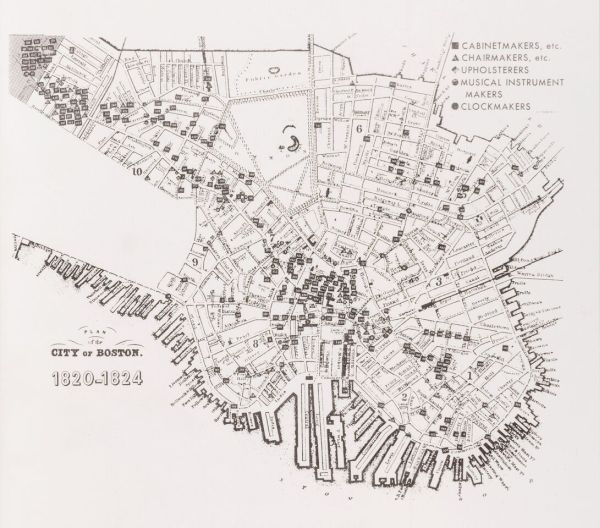
FIG. 13. Map of Boston, showing the distribution of furniture shops, 1820–24. Adapted from PLAN of the CITY OF BOSTON., engraved by G. W. Boynton (active ca. 1830–50), printed by S. N. Dickinson (1801–1848), Boston, 1844. From E. Page Talbott, “The Furniture Industry in Boston, 1810–1835” (master’s thesis, University of Delaware, 1974), appendix A, 168.
Then as now, furniture was a consumer durable. When times were hard, as they often were in the early nineteenth century, families could live with what they had, buy used, or select items with lower unit costs. Furniture warehouses tried to generate retail traffic by offering a wider range of styles and forms and by combining the labor and capital of specialized workers. Thomas Seymour tried this model in 1804 when he and others opened the Boston Furniture Warehouse on the mall south of Boston Common, convenient to the polite townhouses being erected on Beacon Hill. Seymour offered not only “a handsome assortment of Cabinet Furniture, Chairs, Looking-glasses” but also “a general assortment of every article necessary to furnish a house complete.” He also sold secondhand furniture on commission, a nod to the influence of auction sales on price-sensitive Yankee consumers interested in high-quality furniture but unwilling to pay upwards of $100 for a new sideboard. By the 1820s, auction houses had capitalized on the reputations of makers like Seymour and Vose and Coates. In 1825 J. L. Cunningham auctioned “Grecian Card Tables, made by Seymour,” and in 1823 Whitwell, Bond & Co. advertised “1 elegant Secretary, made by Vose and Coats” that originally cost $120. By that time, Isaac Vose was dead, Thomas Seymour was out of work, and the world of small-scale cabinetmakers was a niche market of specialists operating in tandem with factories and subcontractors serving mass retail markets. Even elite Massachusetts families like the Crowninshields mixed high-end furniture with fancy chairs (albeit expensive ones) on pleasure craft such as their yacht Cleopatra’s Barge (fig. 14).30
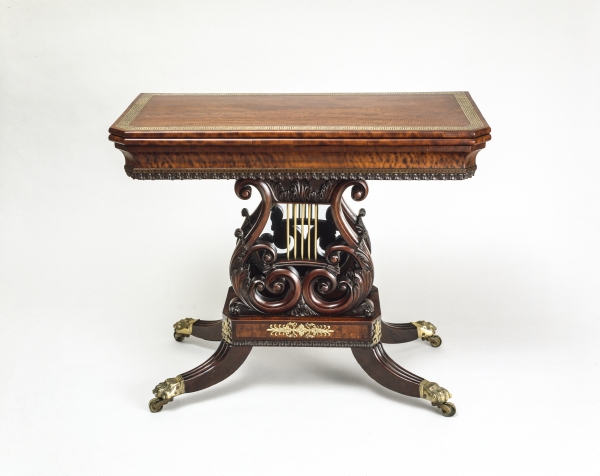
FIG. 14. Card table, attributed to James Barker (active 1816–19), with Thomas Seymour (1771–1848), carving attributed to Thomas Wightman (1759–1827), Boston, 1817. Mahogany, maple, rosewood, ash, cherry, possibly chestnut; h 29½, w 35¾, d 18¾. Peabody Essex Museum; Museum purchase, 1998 (137863). Photo, Jeffrey Dykes. This flamboyant table is one of a pair ordered by George Crowninshield Jr. of Salem for his yacht Cleopatra’s Barge.
Bankruptcy notices marked the failed aspirations of a wide variety of Boston’s furniture-based businessmen and artisans in the 1810s and 1820s. For much of the 1820s and 1830s, small-time cabinetmakers survived alongside big furniture warehouses, where fashionable spaces, inventory costs, and high rents barred casual entry. Some cabinetmakers continued to generate bespoke work or provided repairs; many made furniture that was sold in retail establishments under others’ names, or in auction houses or cooperatives. One such collective was the New Furniture Warehouse, opposite the Old South Church, where cabinetmakers could deposit their wares on commission and sell for “very low cash prices.” In this ferociously competitive range of business models, as revealed in advertisements as well as by fieldwork in Cotton Belt plantation houses, Boston-made objects appeared side by side with those from New York, Philadelphia, Baltimore, or Cincinnati.31
The relentless pressure on unit prices and volume increased the capital costs needed to enter the business. By the 1820s, the marks of machine planers and circular saws were visible on the undersides of birch-top, rope-turned mahogany dining tables like the one made for a respectable middle-class family (fig. 15). Tablecloths masked the cheaper birch top but revealed the mahogany legs. Buyers could pair these tables with factory-made fancy chairs or opt for the more expensive classical forms in mahogany (fig. 16). These Boston classical chairs and table were joined with dowels rather than mortise-and-tenon joints, a cost-saving measure made possible by precision jigs, improved bits, and mortising and dowel-making machines.
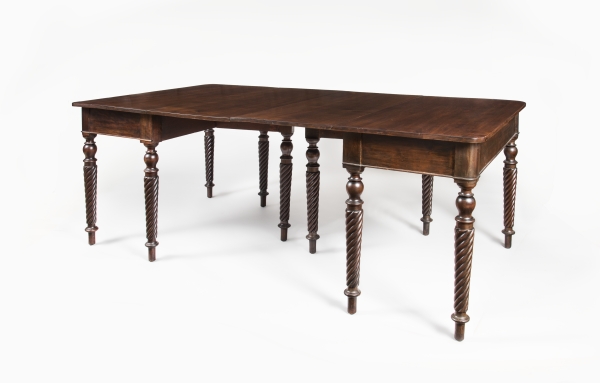
FIG. 15. Two-part dining table, Boston, 1820–40. Mahogany, birch, white pine; h 30, w open 78, d 42. Private collection. Photo, Gavin Ashworth.
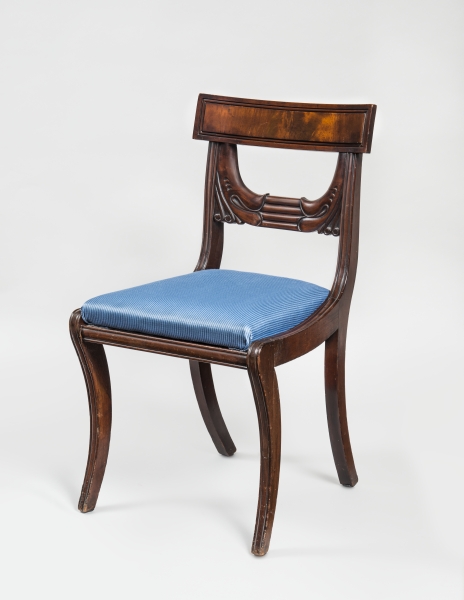
FIG. 16. Side chair, Boston, 1820–30. Mahogany, ash; h 32¾, w 18, d 20. Private collection. Photo, Gavin Ashworth.
The story of Boston furniture craftsmen is not necessarily a sad tale of artisan declension against an incoming tide of mass-produced furniture. By 1830, the city boasted more than 61,000 residents, a figure that would almost triple to just under 178,000 by 1860. That burgeoning population, including many poor immigrants, was well served by factories, cheap furniture warehouses, auction houses, and secondhand shops. During the nineteenth century, designers and manufacturers responded to international and local markets via Restauration, Gothic, French, Italian, Elizabethan, cottage, aesthetic, and colonial revival styles. Many of these coexisted with one another and with furniture passed down from earlier generations or acquired secondhand. The complexity of this history cautions against simple interpretations of cause and effect or stylistic evolution. Humans operating in households blended past and present, as well as expedience, function, and memory, to suit their needs and wants.
If we see furniture as the product of a craft community and not just as objects of artistic merit abstracted from their production and domestic contexts, we surface the constant struggle to make a living amid changing circumstances. Boston’s furniture craftsmen began a regional economy that exerted an extraregional effect in an agriculturally limited environment. Using the opportunistic networks of a maritime world, they mitigated their weaknesses by adjusting to them. They emphasized flexibility, specialization, and cost control. They were aware of stylistic trends around the Atlantic World, but they made furniture that was dependent on profitable markets, not just fashionable design. For a century, they were an outsize force in the furniture trades of the American colonies. As competition from other regions diminished profits and political storms loomed, they and other New England furnituremakers diversified. They copied the competition, specialized in higher-profit goods such as pianos and upholstered lines, moved some production out of town, and invested in new machinery. The patterns of furniture production and retailing that emerged in the first half of the nineteenth century were different from those of earlier times, but they were no less complex or risky than shipping chairs to the Caribbean had been in the 1680s. In that sense, the story of the Boston craft community between 1640 and 1860 is about the making of the modern world.

1. The historiography of Boston furniture is extensive, but a fair amount is merged with broader studies of regional and period furniture and decorative arts. A good starting point is Benno M. Forman, American Seating Furniture, 1630–1730: An Interpretive Catalogue (New York: W. W. Norton, 1988); for the eighteenth century, see Walter Muir Whitehill, Jonathan L. Fairbanks, and Brock Jobe, eds., Boston Furniture of the Eighteenth Century: A Conference Held by the Colonial Society of Massachusetts, 11 and 12 May 1972, Publications of the Colonial Society of Massachusetts, vol. 48 (Boston: Colonial Society of Massachusetts, 1974); and Brock Jobe and Myrna Kaye, with the assistance of Philip Zea, New England Furniture, the Colonial Era: Selections from the Society for the Preservation of New England Antiquities (Boston: Houghton Mifflin, 1984). See also the fine series of articles published in the Chipstone Foundation’s annual serial edited by Luke Beckerdite, American Furniture: David H. Conradsen, “The Stock-in-Trade of John Hancock and Company” (1993): 38–54; Alan Miller, “Roman Gusto in New England: An Eighteenth-Century Boston Furniture Designer and His Shop” (1993): 160–200; Robert Mussey and Anne Rogers Haley, “John Cogswell and Boston Bombé Furniture: Thirty-Five Years of Revolution in Politics and Design” (1994): 73–105; Peter Follansbee and John D. Alexander, “Seventeenth-Century Joinery from Braintree, Massachusetts: The Savell Shop Tradition” (1996): 81–104; Roger Gonzales and Daniel Putman Brown Jr., “Boston and New York Leather Chairs: A Reappraisal” (1996): 175–193; Leigh Keno, Joan Barzilay Freund, and Alan Miller, “The Very Pink of the Mode: Boston Georgian Chairs, Their Export and Their Influence” (1996): 267–306; Joan Barzilay Freund and Leigh Keno, “The Making and Marketing of Boston Seating Furniture in the Late Baroque Style” (1998): 1–40; Glenn Adamson, “The Politics of the Caned Chair” (2002): 174–206; Robert Trent and Michael Podmaniczky, “An Early Cupboard Fragment from the Harvard College Joinery Tradition” (2002): 228–42; Glenn Adamson, “Mannerism in Early American Furniture: Connoisseurship, Intention and Theatricality” (2005): 23–62; Ethan Lasser, “Reading Japanned Furniture” (2007): 169–90; Philip D. Zimmerman, “The ‘Boston Chairs’ of Mid-Eighteenth-Century Philadelphia” (2009): 140–58; Robert Mussey Jr. and Christopher Shelton, “John Penniman and the Ornamental Painting Tradition in Federal-Era Boston” (2010): 2–27; Robert F. Trent, Erik Gronning, and Alan Anderson, “The Gaines Attributions and Baroque Seating in Northeastern New England” (2010): 140-93; Peter Follansbee and Robert F. Trent, “Reassessing the London-Style Joinery and Turning of Seventeenth-Century Boston” (2010): 194–240; Robert F. Trent, “Boston Baroque Easy Chairs, 1705-1740” (2012): 86-115. For a sense of the early nineteenth century in Boston, see Robert D. Mussey Jr., The Furniture Masterworks of John and Thomas Seymour (Salem, Mass.: Peabody Essex Museum, 2003).
2. Walter Muir Whitehill, Boston: A Topographical History (Cambridge: Belknap Press of Harvard University Press, 1968), 1–21; Nancy Seasholes, Gaining Ground: A History of Landmaking in Boston (Cambridge: MIT Press, 2004), 21–152; Darrett B. Rutman, Winthrop’s Boston: Portrait of a Puritan Town, 1630–1649 (Chapel Hill: University of North Carolina Press for the Institute of Early American History and Culture, 1965), 23–40; Daniel Vickers with Vince Walsh, Young Men and the Sea: Yankee Seafarers in the Age of Sail (New Haven: Yale University Press, 2005), 7–24.
3. Rutman, Winthrop’s Boston, 68–97, 164–201.
4. Whitehill, Boston, 29–46; Seasholes, Gaining Ground, 21–72; for more on the economy and population figures, see John J. McCusker and Russell R. Menard, The Economy of British America, 1607–1789 (Chapel Hill: University of North Carolina Press for the Institute of Early American History and Culture, 1985), 91–116, esp. 103, table 5.1.
5. Forman, American Seating Furniture, 3–18; Brock Jobe, “The Boston Furniture Industry, 1720–1740” (master’s thesis, University of Delaware, 1976), 3–48. In Whitehill, Fairbanks, and Jobe, Boston Furniture of the Eighteenth Century, see esp. Dean A. Fales Jr., “Boston Japanned Furniture,” 49–75; Margaretta Markle Lovell, “Boston Blockfront Furniture,” 77–135; and Gilbert T. Vincent, “The Bombé Furniture of Boston,” 137–96. For a discussion of the London furniture trade, see Adam Bowett, Early Georgian Furniture, 1715–1740 (Woodbridge, Suffolk: Antique Collectors’ Club, 2009), 10–53.
6. For a critique of this kind of thinking, see Bowett, Early Georgian Furniture, 5–9; Forman, American Seating Furniture, 3–18.
7. Whitehill captures the sense of the town in an imagined eighteenth-century walking tour in Boston, 29–37.
8. Vickers, Young Men and the Sea, 41–45; Bernard Bailyn, New England Merchants in the Seventeenth Century (Cambridge: Harvard University Press, 1979), 76–86; Bernard Bailyn and Lotte Bailyn, Massachusetts Shipping: A Statistical Study (Cambridge: Belknap Press of Harvard University Press, 1959), 20–21, table 1; Forman, American Seating Furniture, 39–62; Charles F. Carroll, The Timber Economy of Puritan New England (Providence, R.I.: Brown University Press, 1973), 140; Benno Forman, “Mill Sawing in Seventeenth-Century Massachusetts,” Old-Time New England 60, no. 220 (Spring 1970): 110–30.
9. William Avery Baker, “Vessel Types of Colonial Massachusetts,” in Seafaring in Colonial Massachusetts (Boston: Colonial Society of Massachusetts, 1980), 3–29. For a valuable Atlantic World perspective on risk and business management, see Peter Mathias, “Risk, Credit and Kinship in Early Modern Enterprise,” in The Early Modern Atlantic Economy, ed. John J. McCusker and Kenneth Morgan (Cambridge: Cambridge University Press, 2000), 1–35.
10. Forman covers the basic elements of the seventeenth-century woodworking trades from tools to techniques in American Seating Furniture, 39–62. Vickers explores the ways in which even the first generation of seafaring families developed a complex economy in Young Men and the Sea, 41–60. Also helpful for a broad introduction to the city’s mercantile community is Phyllis Whitman Hunter, Purchasing Identity in the Atlantic World: Massachusetts Merchants, 1670–1780 (Ithaca, N.Y.: Cornell University Press, 2001).
11. Adams’s shop inventory is partly analyzed in Forman, American Seating Furniture, 51. It included, among other things, “7 doz. Of Large wooden Platters” valued at 8 shillings per dozen; “6 dz. of hollow turnd ware” at 6s. per dozen; “8 gross of taps [for kegs] at 5s. pr. gross”; “5 grosse & five doz. of trenchers” at 8s. per gross; “4 grosse of woodden Spoons” at 4s. per gross; “1 doz. of woodden Sives” worth 9s.; “15 new Chaires at 2s. pr. ps.”; “48 chairs unbottomed at 18s. pr. ps.”; “4 grosse of Sive Rimmes at 3s. doz”; and “timber at the wharfe” worth £5.
12. Adamson, “Politics of the Caned Chair,” 174–206; Forman, American Seating Furniture, 229–79.
13. Cited in Neil Kamil, Fortress of the Soul: Violence, Metaphysics, and Material Life in the Huguenots’ New World, 1517–1751 (Baltimore: Johns Hopkins University Press, 2005), 714. Seasholes discusses the development of Long Wharf in Gaining Ground, 29–31.
14. Fitch’s letter and the growing competition with New York chairmakers are cited and explored in Kamil, Hidden in Plain Sight, 717.
15. For discussion of the locations of furniture shops in the eighteenth century, see Jobe, “Boston Furniture Industry,” 3–12. John Lane’s information is cited in Forman, American Seating Furniture, 242; for more on Lane, see Jobe, “Boston Furniture Industry,” 73.
16. For a general sense of the era, see George Brown Tindall, America: A Narrative History, 2d ed. (New York: W. W. Norton, 1988), 1:162–82; Bernard Bailyn, Voyagers to the West: A Passage in the Peopling of America on the Eve of the Revolution (New York: Vintage Books, 1986), 204–39.
17. Nancy E. Richards and Nancy Goyne Evans, with Wendy A. Cooper and Michael S. Podmaniczky, New England Furniture at Winterthur: Queen Anne and Chippendale Periods (Winterthur, Del.: Henry Francis du Pont Winterthur Museum, 1997); Jobe and Kaye, New England Furniture, 4–46.
18. Discussed in Jobe, “Boston Furniture Industry,” 62–63.
19. Ibid., 64–68; the inventory of Crockford’s shop and tools is on 66–68.
20. Ibid., Stephen Fullerton, 68; William Fullerton Sr., 69; William Fullerton Jr., 69.
21. Forman argues this basic point in American Seating Furniture, 243–49.
22. Margaretta Lovell found the same pattern in her article “‘Such Furniture as Will Be Most Profitable’: The Business of Cabinetmaking in Eighteenth-Century Newport,” Winterthur Portfolio 26, no. 1(Spring 1991): 27–62.
23. Nancy Goyne Evans, American Windsor Chairs (New York: Hudson Hills Press in association with the Henry Francis du Pont Winterthur Museum, 1996), see esp. 65–74. In a personal communication to the author, Nancy Evans indicated that she felt the form was in America as early as the 1720s.
24. Evans, American Windsor Chairs, 79–98, 462–74.
25. Jacqueline Barbara Carr, After the Siege: A Social History of Boston, 1775–1800 (Boston: Northeastern University Press, 2005), 13–42; the advertisement for John Wadsworth is in the American Mercury, Feb. 9, 1804.
26. Carr, After the Siege, 13–42.
27. One of the best explanations of the commercial politics of this era is James R. Fichter, So Great a Profit: How the East Indies Trade Transformed Anglo-American Capitalism (Cambridge: Harvard University Press, 2010), 56–81.
28. Seasholes, Gaining Ground, 134–89; J. Ritchie Garrison, Two Carpenters: Architecture and Building in Early New England, 1799–1859 (Knoxville: University of Tennessee Press, 2006), 29–47; Mussey, John and Thomas Seymour, 28–77.
29. E. Page Talbott, “The Furniture Industry in Boston, 1810–1835” (master’s thesis, University of Delaware, 1974); the maps are in appendix A, 164–70. See also Stuart P. Feld, with an introductory essay by Page Talbott, Boston in the Age of Neo-Classicism, 1810–1840 (New York: Hirschl & Adler Galleries, 2000), 12–39; as well as several articles by Talbott, including “Boston Empire Furniture, Part I,” Antiques 107, no. 5 (May 1975): 878–87; “Boston Empire Furniture, Part II,” Antiques 109, no. 5 (May 1976): 1004–13; “Classical Conservatism: Card Tables and the English Regency Style in Boston, 1810–35,” Maine Antique Digest 17, no. 12 (Dec. 1989): 10c–16c; “Seating Furniture in Boston, 1810–1835,” Antiques 139, no. 5 (May 1991): 956–69; “The Furniture Trade in Boston, 1810–1835,” Antiques 112, no. 5 (May 1992): 842–55.
30. Independent Chronicle, Jan. 24, 1805; Boston Commercial Gazette, Sep. 10, 1818; Salem Gazette, May 21, 1819; Repertory, Oct. 29, 1822; Boston Daily Advertiser, Apr. 29, 1823; Mussey, John and Thomas Seymour, 362–63; Feld, Boston in the Age of Neo-Classicism, passim.
31. See, for example, Boston Daily Advertiser, June 20, 1814; Independent Chronicle and Boston Patriot, Oct. 19, 1822; and Boston Daily Advertiser, Mar. 31, 1831.

